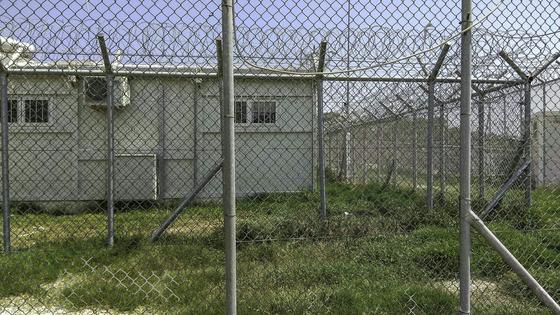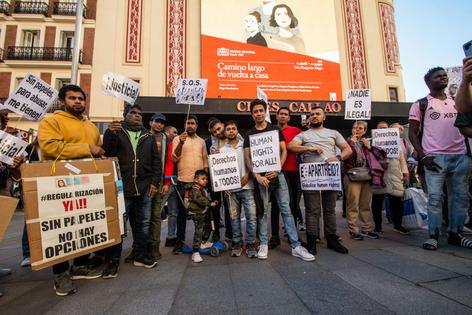EU migration overhaul stresses fast-track deportations and limited appeal rights for asylum seekers
Published in Political News
The European Parliament adopted its Pact on Migration and Asylum on April 10, 2024, clearing a major hurdle on its way to becoming European Union law. The package of regulations and directives seeks to update EU policies on migrants and refugees.
The pact is a legacy of the 2015 migration crisis when EU countries saw more than 1 million people claim asylum after arriving, mainly by boat, to European countries. The majority were fleeing violence and war in Syria, Afghanistan and Iraq.
Front-line European countries, including Greece and Italy, were overwhelmed by the sheer numbers, prompting anti-migrant violence and a backlash from far-right political parties.
During the crisis, some European states, including Macedonia, Croatia and Slovenia, closed their borders, effectively trapping 60,000 people in Greece living in tent cities.
I am a political scientist researching how states and international organizations address issues relating to refugees. In 2016, I visited some of the camps in Greece. Authorities there were struggling to provide the bare minimum of aid and failing to provide legal protection or process asylum claims. Many of these people waited years for a appointment to examine their asylum applications. Greece still had a backlog of 22,316 asylum cases in 2022.
As such, the need for migration reform has been clear. European leaders hope the newly agreed pact will prevent future migration crises in Europe by tightening borders, making it easier to deport asylum applicants and spreading the caseload across the EU’s 27 member states.
But to critics of the pact, the reforms will institutionalize inequality, instrumentalize migration crises and ignore the actual holes in migration governance.
The new EU pact follows years of debate over migration by member states, a theme I explore in my book “Delegating Responsibility.”
In response to the 2015 crisis, the European Council adopted a mandatory quota system the following year to redistribute refugees to all member states based on the size of their economies, population and own asylum caseloads. Hungary, the Czech Republic and Poland refused to participate, and in 2020 the EU Court of Justice found they had broken EU law.
Nevertheless, the quota system was never scaled up, leaving front-line states to continue to process much of Europe’s refugee population.
Since 2016, the European Commission has proposed multiple reforms, but negotiations stalled because of opposition from far-right governments in Eastern Europe. Viktor Orbán, Hungary’s prime minister, opposed reforms in 2018, saying: “We must send migrants back to their countries. Brussels says we cannot do it. They also had said it was impossible to stop migrants on land, but we did it.”
Substantively, the new pact consists of six major reforms – all of which focus on securitizing borders and making it easier to deport people, with, critics argue, little protection for migrants and asylum seekers.
The first regulation expands the EU’s biometric database for asylum seekers, EURODAC, to include the fingerprints, face photos and biographical information of all individuals aged 6 and above. Previously, the database included only fingerprints – not images or biographic details – of people above the age of 14. The pact also makes it easier for police to access the database.
Second, the asylum and migration management regulation, or AMMR, continues the Dublin Regulation requiring asylum applications to be reviewed by the first member state they enter.
This means that Greece and Italy will continue to process most asylum claims. But the AMMR does allow transfers to a third country based on an applicant’s family ties, prior residency or education in another member state.
These first two regulations will have immediate legal impact when endorsed by the the 27 EU member countries in the European Council before June 2024.
The other four directives must be incorporated into EU member states’ domestic laws within the next two years. Together, these other four directives work to make it harder for people to make asylum claims in the EU.
For example, the pact institutionalizes the policy that “hotspot” reception centers on islands off Greece and Italy are transit zones and thus not EU territory. This effectively excises many Mediterranean islands from EU territory in order to block asylum seekers from their full rights.
Another directive revises asylum procedures to fast-track deportations of people who have traveled via a “safe third country” or if they are from a country with recognition rates – the proportion of asylum applications that are approved from a given country of origin – below 20%.
Human rights groups criticize the pact because fast-track deportations are based on group characteristics, instead of individual review. They claim that the reforms also undermine the right of appeal – sometimes deporting people before an appeals decision is finalized – and expand detention.
The EU isn’t alone in attempting to make it harder to seek asylum. Similar to the EU’s “safe third country” policy, the Biden administration implemented the “lawful pathways” rule in May 2023 – which was blocked and later reinstated. Biden’s executive order paralleled President Donald Trump’s earlier transit and entry bans, arguing that asylum seekers must apply in the first safe country they transit. Courts blocked Trump and initially blocked Biden because U.S. law guarantees anyone the right to apply for asylum regardless of their previous immigration status or how they entered the U.S. The rule is currently on pause awaiting settlement.
The EU reforms also parallel recent proposals from Biden to shut down the border during migration surges. The pact creates a new procedure to suspend normal asylum rules if a country on the external EU border is “instrumentalizing migration” –in other words, if a country is intentionally sending migrants or refugees with the goal of destabilizing the EU.
This provision speaks to the fear that non-EU member Belarus was “weaponizing migration” in 2021 by encouraging Syrians and Iraqis to cross the border into Poland, an EU state.
There is growing academic literature on “migration diplomacy” and “refugee blackmail” that documents how states leverage migration flows as a tool in their foreign policy.
However, the EU pact’s approach suspends the rights of asylum seekers rather than addressing the larger geopolitical threats.
The most controversial directive resurrects quotas but with a “flexible solidarity mechanism.” This mechanism would be triggered if large numbers of asylum seekers enter an EU state, overwhelming their reception system. In those circumstances, other EU states could choose to either take in asylum seekers from front-line states or fund deportations. States would be required to relocate at least 30,000 people per year, but could choose to pay 20,000 euros (US$21,000) for each person.
Critics argue that this commodifies refugees – literally putting a price tag on individual lives – while undermining solidarity.
The need for EU migration reform was made clear by the 2015 crisis faced by front-line European countries.
But rather than address the real problems of low state capacity, processing times, human rights protections, or conditions in detention centers, I believe the pact will reinforce the concept of “Fortress Europe” by investing in deterrence and deportation, not human rights.
This article is republished from The Conversation, a nonprofit, independent news organization bringing you facts and analysis to help you make sense of our complex world.
Read more:
EU enlargement: What does the future hold?
What are the EU’s new migration rules, and why did they take so long to pass?
Nicholas R. Micinski does not work for, consult, own shares in or receive funding from any company or organization that would benefit from this article, and has disclosed no relevant affiliations beyond their academic appointment.




























































Comments